Elegant, talented and funny Audrey Hepburn (1929-1993) was a Belgian-born, British-Dutch actress and humanitarian. After a start in European cinema, she became one of the most successful Hollywood stars of the 1950s and 1960s.
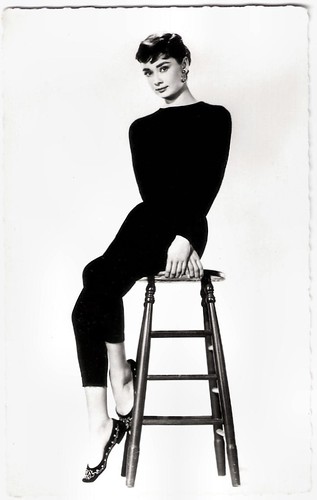
French postcard by Editions du Globe, Paris, no. 385. Photo: Paramount / P.P.C. Publicity still for Sabrina (Billy Wilder, 1954). Costume: Hubert de Givenchy.
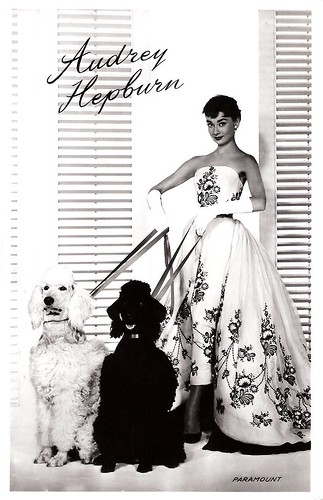
Dutch postcard by Takken, Utrecht, no. 1530. Photo: Paramount. Publicity still for Sabrina (Billy Wilder, 1954). Costume: Hubert de Givenchy.
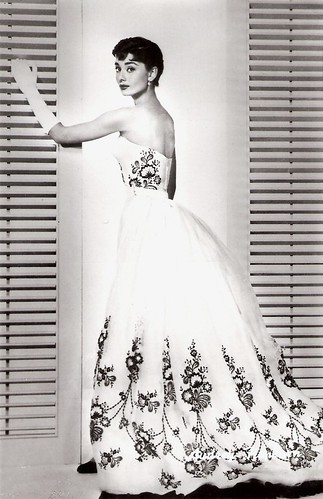
French postcard. Publicity still for Sabrina (Billy Wilder, 1954). Costume: Hubert de Givenchy.

French postcard by Editions du Globe, Paris, no. 384. Photo: Paramount / PPC, 1955. Audrey Hepburn in Sabrina (Billy Wilder, 1954). Costume: Hubert de Givenchy.

German postcard by Tushita, Duisburg / Innenhalen, no. B 489. Photo: Transglobe /Popperfoto. Audrey Hepburn was five times nominated for an Academy Award, and was awarded in 1954 the Academy Award for Best Actress for her performance in Roman Holiday (William Wyler, 1953).
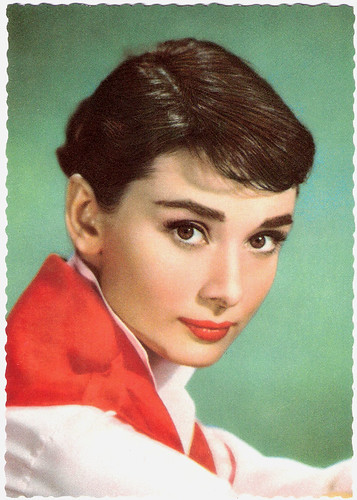
German postcard by Ufa, Berlin-Tempelhof, no. CK-5. Retail price: 30 Pfg. Photo: Paramount Film.

French postcard. Unknown editor and photographer.

Italian postcard by Emilio Modric Editore, Ancona, no. MX 243. Photo: Audrey Hepburn in Breakfast at Tiffany's (Blake Edwards, 1961).
Audrey Hepburn was born Audrey Kathleen Ruston in Ixelles/Elsene, a municipality in Brussels, Belgium, in 1929. She was the only child of Joseph Victor Anthony Ruston, a Briton, and his second wife, the former Baroness Ella van Heemstra, a Dutch aristocrat, who was the daughter of a former governor of Dutch Guiana.
Her father later used the surname of his maternal grandmother, Kathleen Hepburn, to the family and her surname became Hepburn-Ruston. Hepburn's father's job with a British insurance company meant the family travelled often between Brussels, England, and The Netherlands. In 1935, her parents divorced and her father, a Nazi sympathiser, left the family.
In 1939, her mother moved her and her two half-brothers to their grandfather's home in Arnhem in the Netherlands, believing the Netherlands would be safe from a German attack. Hepburn attended the Arnhem Conservatory from 1939 to 1945, where she trained in ballet along with the standard school curriculum. In 1940, the Germans invaded the Netherlands. During the German occupation, Hepburn adopted the pseudonym Edda van Heemstra, modifying her mother's documents because an 'English-sounding' name was considered dangerous.
By 1944, Audrey had become a proficient ballerina. She secretly danced for groups of people to collect money for the Dutch resistance. During the Dutch famine that followed, over the winter of 1944, people starved and froze to death in the streets. Hepburn and many others resorted to making flour out of tulip bulbs to bake cakes and biscuits. Hepburn's wartime experiences later led her to become involved with UNICEF.
In 1945, after the war, Hepburn left the Arnhem Conservatory and moved to Amsterdam, where she took ballet lessons with Lithuanian-Dutch-Jewish dancer and choreographer Sonia Gaskell. Hepburn made her first film appearance in Nederlands in 7 lessen/Dutch in Seven Lessons (Charles Huguenot van der Linden, Heinz Josephson, 1948), a Dutch film made for KLM Royal Dutch Airlines. It had a film-within-the-film scenario involving a cameraman who's given a week to photograph the aerial highlights of Holland for a travelogue. Hepburn played the stewardess.
She then travelled with her mother to London. Gaskell provided an introduction to Marie Rambert, and Hepburn studied ballet at the Ballet Rambert, supporting herself with part-time work as a model. Rambert warned her that she could not become a prima ballerina, because she was relatively tall (1.7m). Audrey decided to pursue an acting career instead.

British postcard by Acme Cards, London, no. AM 1. Photo: Angus McBean, 1951.

Belgian promotion card for Supernylons Plaza. The card refers to the British film Young Wives' Tale (Henry Cass, 1951) with 22-year-old Audrey Hepburn in her fourth film, two years before Roman Holiday (William Wyler, 1953). Collection: Marlene Pilaete.

Dutch postcard by Takken / 't Sticht, Utrecht, no. 1469. Photo: Paramount. Audrey Hepburn in Roman Holiday (William Wyler, 1953).

German postcard by Kunst und Bild, Berlin, no. A 1031. Photo: Paramount. Publicity still for Roman Holiday (William Wyler, 1953).

German postcard by Kunst und Bild, Berlin, no. A 1079. Photo: Paramount. Audrey Hepburn and Gregory Peck in Roman Holiday (William Wyler, 1953).
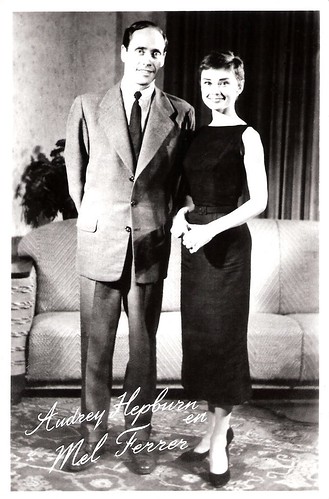
Dutch postcard by Takken, Utrecht, no. 1598. With Mel Ferrer.

Dutch postcard by Takken, Utrecht, no. 1599. Audrey Hepburn visited Arnhem after the war.

Italian postcard by Bromofoto, Milano (Milan).
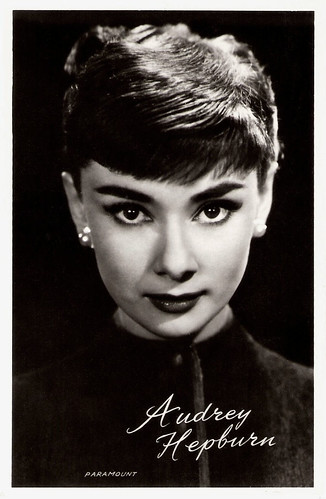
Dutch postcard by Takken, Utrecht, no. 1422. Photo: Paramount.

West German postcard by Kolibri Verlag, Minden/Westf., no. 2884.
In London, Audrey Hepburn played in musical theatre in productions such as 'High Button Shoes' and 'Sauce Piquante'. Her theatre work revealed that her voice was not strong and needed to be developed, and during this time she took elocution lessons with the actor Felix Aylmer.
Part-time modelling work was not always available and Hepburn registered with the casting officers of Britain's film studios in the hope of getting work as an extra. Hepburn's first British film role was in the farce One Wild Oat (Charles Saunders, 1951) in which she played a hotel receptionist. She played several more small roles in Young Wives' Tale (Henry Cass, 1951), Laughter in Paradise (Mario Zampi, 1951), the classic crime comedy The Lavender Hill Mob (Charles Crichton, 1951), and the comedy Monte Carlo Baby (Jean Boyer, Lester Fuller, 1951).
Monte Carlo Baby was shot at the same time as the French-language version, Nous irons à Monte Carlo (Jean Boyer, 1952). During the filming, Hepburn met the famous author Colette, who recommended her for the lead character of a stage version of her novel 'Gigi' on Broadway.
Colette reportedly said when she first saw Hepburn "Voilà! There's our Gigi!" The play opened on 24 November 1951 and ran for 219 performances. Audrey won a Theatre World Award for her performance. Hepburn's first significant film performance was in the British crime drama Secret People (Thorold Dickinson, 1952), starring Valentina Cortese. Audrey played a prodigious ballerina and did all of her own dancing scenes.
Her first starring role was opposite Gregory Peck in the Italian-set Roman Holiday (William Wyler, 1952). Producers initially wanted Elizabeth Taylor for the role of Princess Ann, but director William Wyler was so impressed by Hepburn's screen test (the camera was left on and candid footage of Hepburn relaxing and answering questions, unaware that she was still being filmed, displayed her talents), that he cast her in the lead. For her enchanting role in Roman Holiday, she would win an Academy Award, a Golden Globe and a BAFTA. Paramount signed her to a seven-picture contract with twelve months in between films to allow her time for stage work.
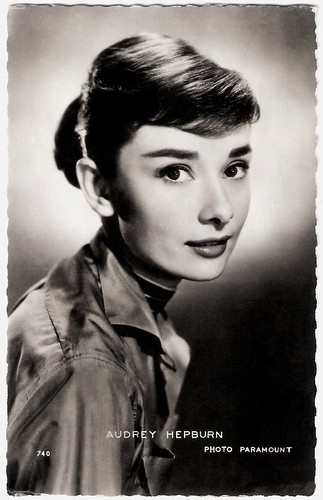
French postcard by Editions P.I., Paris, no. 740. Photo: Paramount, 1956.

French postcard by Editions P.I., Paris, no. 787. Photo: Paramount Pictures, 1956.
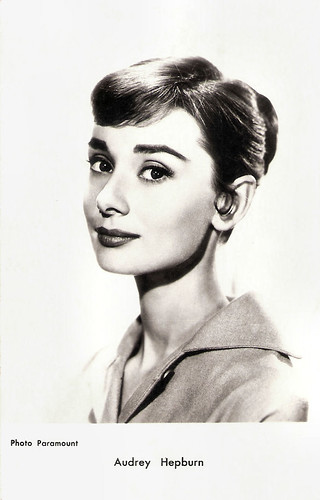
French postcard by Editions P.I., Paris, no. 788. Photo: Paramount.
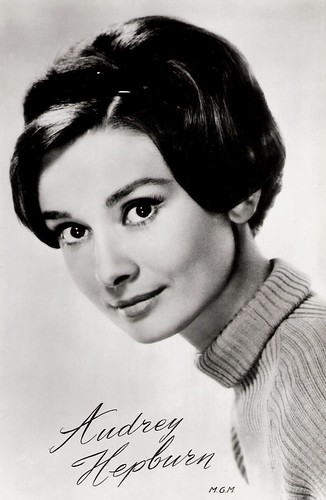
Dutch postcard by Uitg. Takken, Utrecht, no. 4244. Photo: MGM. Publicity still for Green Mansions (Mel Ferrer, 1959).
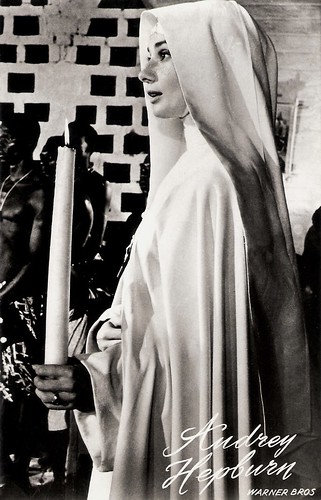
Dutch postcard by Takken, Utrecht, no. 4175. Photo: Warner Bros. Publicity still for The Nun's Story. (Fred Zinnemann, 1959).

French promotion card by Warner Bros. Photo: Warner Bros. Audrey Hepburn in The Nun's Story (Fred Zinnemann, 1959).

French promotion card by Warner Bros. Photo: Warner Bros. Audrey Hepburn in The Nun's Story (Fred Zinnemann, 1959).
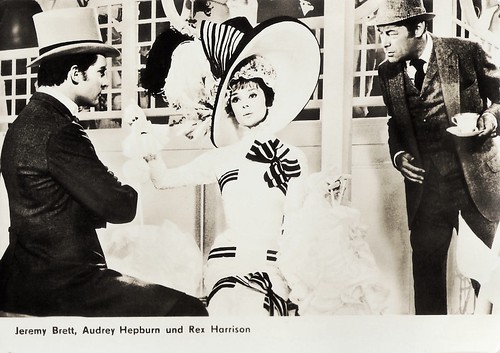
East-German postcard by VEB-Progress Film-Vertrieb, Berlin, no. 2989. Retail price: 0,20 MDM. Photo: Warner Bros. Publicity still for My Fair Lady (George Cukor, 1964) with Jeremy Brett and Rex Harrison. Costumes: Cecil Beaton.
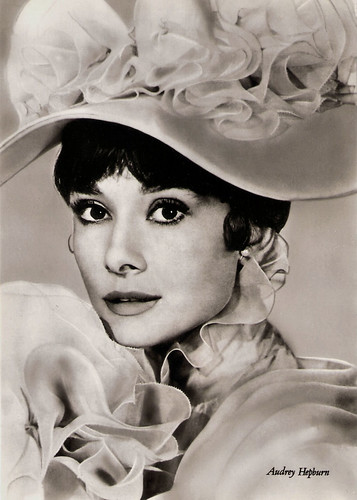
East-German postcard by VEB-Progress Film-Vertrieb, Berlin, no. 2988. Retail price: 0,20 MDM. Photo: Warner Bros. Publicity still for My Fair Lady (George Cukor, 1964). Costume: Cecil Beaton.

East-German postcard by VEB-Progress Film-Vertrieb, Berlin, no. 3028. Retail price: 0,20 MDM. Photo: Warner Bros. Publicity still for My Fair Lady (George Cukor, 1964). Costume: Cecil Beaton.
After Roman Holiday, Audrey Hepburn filmed Sabrina (Billy Wilder, 1954) with Humphrey Bogart and William Holden. Hepburn was sent to a then-young and upcoming fashion designer Hubert de Givenchy to decide on her wardrobe. Their creative partnership endured for the remainder of Hepburn’s life. Audrey Hepburn wore De Givenchy creations in some of her most renowned films, such as How to Steal a Million (William Wyler, 1966) and Breakfast at Tiffany’s (Blake Edwards, 1961).
In 1954, she returned to the stage to play the water sprite in 'Ondine' in a performance with Mel Ferrer, who she would marry later in the year. She also won a Tony Award for her performance in 'Ondine' (1954). Hepburn is one of only three actresses to receive a Best Actress Oscar and Best Actress Tony in the same year - the others were Shirley Booth and Ellen Burstyn.
Audrey Hepburn was now one of the most successful film actresses in the world, but also a major fashion influence. Her gamine and elfin appearance and widely recognised sense of chic were both admired and imitated. She co-starred with such notable leading men as Henry Fonda in War and Peace (King Vidor, 1956), Fred Astaire in Funny Face (Stanley Donen, 1957), Maurice Chevalier and Gary Cooper in Love in the Afternoon (Billy Wilder, 1957), Anthony Perkins in Green Mansions (Mel Ferrer, 1959), and Burt Lancaster in The Unforgiven (John Huston, 1960).
According to Denny Jackson at IMDb, "Audrey reached the pinnacle of her career when she played Holly Golightly in the delightful film Breakfast at Tiffany's (1961). For this, she received another Oscar nomination." Opposite Shirley MacLaine, she starred in The Children's Hour (William Wyler, 1961). She scored another box office hit with the espionage caper Charade (Stanley Donen, 1963) with Cary Grant. One of her most radiant roles was as Eliza Doolittle in the film version of My Fair Lady (George Cukor, 1964), opposite Rex Harrison. She became only the third actor to receive $1,000,000 for a film role. She followed it with roles opposite Peter O'Toole in How to Steal a Million (William Wyler, 1966) and Albert Finney in Two for the Road (Stanley Donen, 1967).
Audrey Hepburn received Academy Award nominations for Sabrina (Billy Wilder, 1954), The Nun's Story (Fred Zinnemann, 1959), Breakfast at Tiffany's (Blake Edwards, 1961) and Wait Until Dark (Terence Young, 1967), and won BAFTA Awards for her performances in The Nun's Story(Fred Zinnemann, 1959) and Charade (Stanley Donen, 1963). After Wait Until Dark (1967) and 15 years of continuous success, she took a break from film-making from 1968 to 1975, mostly to spend more time with her two sons.

French postcard by E.D.U.G., no. 129.

West German postcard by Schumann-Verlag, Berlin-Dahlem. Photo: Star Revue.
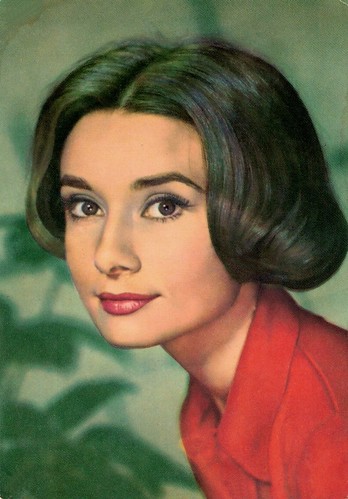
Spanish postcard by Postal Oscarcolor, no. F-179.
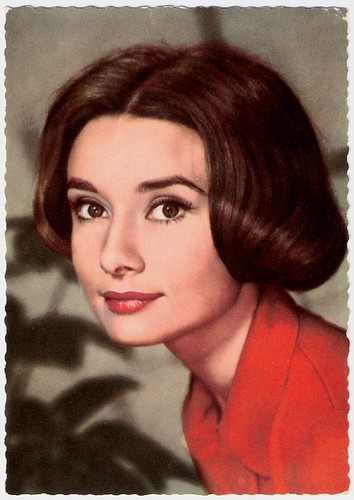
German postcard by Ufa (Universum-Film Aktiengesellschaft, Berlin-Tempelhof), no. CK-179. Photo: Terb Agency / Ufa. The retail price was 30 Pfg.

Big Dutch autograph card.

French postcard by E.D.U.G., no. 222.

Dutch collectors card by the School of Dancing Joy, Amsterdam, no. 25. Audrey Hepburn in Breakfast at Tiffany's (Blake Edwards, 1961). On the flip side are the basic steps of the slow waltz printed.
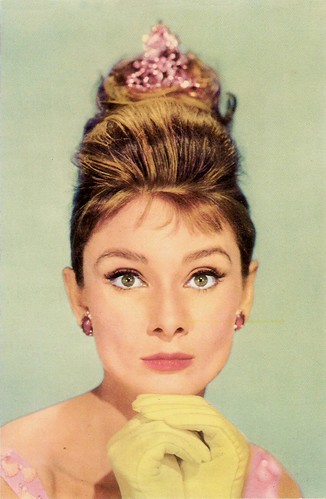
Israelian postcard by Editions De Luxe, no. 130. Photo: publicity still for Breakfast at Tiffany's (Blake Edwards, 1961).
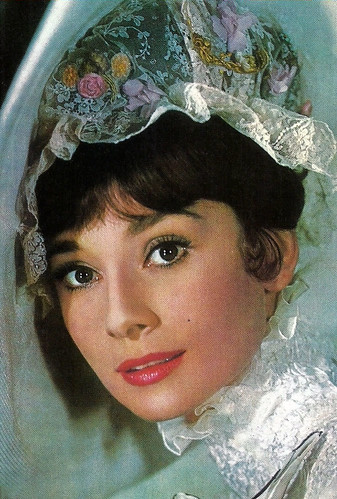
Spanish postcard by Oscarcolor. Audrey Hepburn in My Fair Lady (George Cukor, 1964).
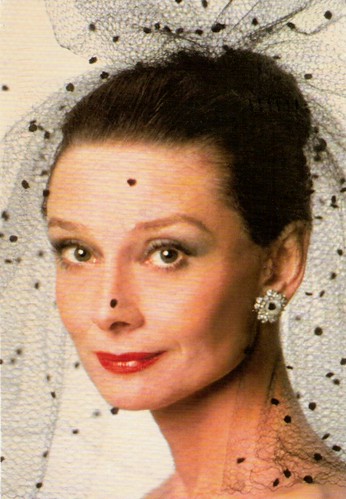
American postcard.
In 1976 Audrey Hepburn returned to the screen with Sean Connery in the period piece Robin and Marian (Richard Lester, 1976), which was moderately successful.
Three years later she took the leading role in the international production Bloodline (Terence Young, 1979) based on a novel by Sidney Sheldon. The film, an international intrigue amid the jet-set, was a critical and box office failure. Another commercial failure was the mad cap private-eye caper They All Laughed (Peter Bogdanovich, 1981). In 1989 she made her last film appearance as an angel in the romantic comedy Always (Steven Spielberg, 1989) starring Richard Dreyfuss.
Her wartime experiences inspired her passion for humanitarian work, and although she had worked for the United Nations Children's Fund (UNICEF) since the 1950s, during her later life, she dedicated much of her time and energy to the organisation. From 1988 until 1992, she worked in some of the most profoundly disadvantaged communities of Africa, South America and Asia. In 1992, she was awarded the Presidential Medal of Freedom in recognition of her work as a UNICEF Goodwill Ambassador.
After her divorce from American actor Mel Ferrer, Hepburn married Italian psychiatrist Dr. Andrea Dotti. She had a son with each – Sean (1960) by Ferrer, and Luca (1970) by Dotti. From 1980 until her death, she lived with the Dutch actor Robert Wolders.
In 1993, Audrey Hepburn died of appendiceal cancer at her home in Tolochenaz, Switzerland at the age of 63. She was posthumously awarded The Jean Hersholt Humanitarian Award by the Academy of Motion Picture Arts and Sciences for her humanitarian work. She received a posthumous Grammy Award for her spoken word recording, Audrey Hepburn's Enchanted Tales in 1994, and in the same year, won an Emmy Award for Outstanding Achievement for Gardens of the World with Audrey Hepburn, thereby becoming one of a few people to receive an Academy, Emmy, Grammy and Tony award. In 1999, she was ranked as the third greatest female star of all time by the American Film Institute.
Scenes from Nederlands in 7 lessen/Dutch in Seven Lessons (1948). Source: EverythingAudrey.com (YouTube).
Audrey Hepburn in Laughter in Paradise (1951). Source: My username is Robyn (YouTube).
Scenes from Secret People (1952). Source: EverythingAudrey.com (YouTube).
The screen test by William Wyler for Roman Holiday (1952). Source: Haphazard Studios (YouTube).
Audrey Hepburn and her husband Mel Ferrer visit the Netherlands to attend a film premiere of El Greco starring Mel Ferrer. Source: FabAudrey (YouTube).
Trailer of Breakfast at Tiffany's (1961). Source: FabAudrey (YouTube).
The Fashion Designer and His Muse - Audrey Hepburn and Hubert de Givenchy. Source: Nanda (YouTube).

Swiss postcard by CVB Publishers, no. 57255. Photo: Collection Cinémathèque Suisse, Lausanne. Gregory Peck and Audrey Hepburn in Roman Holiday (William Wyler, 1953).

American postcard in the Magic of the Movies Series by Mayfair Cards, no. FP 859. Lobby card: Warner Bros / Reel Poster Archive. Audrey Hepburn and Rex Harrison in My Fair Lady (George Cukor, 1964).
Sources: Denny Jackson and Volker Boehm (IMDb), Gemeentemuseum Den Haag (page now defunct), Wikipedia and IMDb.

French postcard by Editions du Globe, Paris, no. 385. Photo: Paramount / P.P.C. Publicity still for Sabrina (Billy Wilder, 1954). Costume: Hubert de Givenchy.

Dutch postcard by Takken, Utrecht, no. 1530. Photo: Paramount. Publicity still for Sabrina (Billy Wilder, 1954). Costume: Hubert de Givenchy.

French postcard. Publicity still for Sabrina (Billy Wilder, 1954). Costume: Hubert de Givenchy.

French postcard by Editions du Globe, Paris, no. 384. Photo: Paramount / PPC, 1955. Audrey Hepburn in Sabrina (Billy Wilder, 1954). Costume: Hubert de Givenchy.

German postcard by Tushita, Duisburg / Innenhalen, no. B 489. Photo: Transglobe /Popperfoto. Audrey Hepburn was five times nominated for an Academy Award, and was awarded in 1954 the Academy Award for Best Actress for her performance in Roman Holiday (William Wyler, 1953).

German postcard by Ufa, Berlin-Tempelhof, no. CK-5. Retail price: 30 Pfg. Photo: Paramount Film.

French postcard. Unknown editor and photographer.

Italian postcard by Emilio Modric Editore, Ancona, no. MX 243. Photo: Audrey Hepburn in Breakfast at Tiffany's (Blake Edwards, 1961).
Wartime in Arnhem
Audrey Hepburn was born Audrey Kathleen Ruston in Ixelles/Elsene, a municipality in Brussels, Belgium, in 1929. She was the only child of Joseph Victor Anthony Ruston, a Briton, and his second wife, the former Baroness Ella van Heemstra, a Dutch aristocrat, who was the daughter of a former governor of Dutch Guiana.
Her father later used the surname of his maternal grandmother, Kathleen Hepburn, to the family and her surname became Hepburn-Ruston. Hepburn's father's job with a British insurance company meant the family travelled often between Brussels, England, and The Netherlands. In 1935, her parents divorced and her father, a Nazi sympathiser, left the family.
In 1939, her mother moved her and her two half-brothers to their grandfather's home in Arnhem in the Netherlands, believing the Netherlands would be safe from a German attack. Hepburn attended the Arnhem Conservatory from 1939 to 1945, where she trained in ballet along with the standard school curriculum. In 1940, the Germans invaded the Netherlands. During the German occupation, Hepburn adopted the pseudonym Edda van Heemstra, modifying her mother's documents because an 'English-sounding' name was considered dangerous.
By 1944, Audrey had become a proficient ballerina. She secretly danced for groups of people to collect money for the Dutch resistance. During the Dutch famine that followed, over the winter of 1944, people starved and froze to death in the streets. Hepburn and many others resorted to making flour out of tulip bulbs to bake cakes and biscuits. Hepburn's wartime experiences later led her to become involved with UNICEF.
In 1945, after the war, Hepburn left the Arnhem Conservatory and moved to Amsterdam, where she took ballet lessons with Lithuanian-Dutch-Jewish dancer and choreographer Sonia Gaskell. Hepburn made her first film appearance in Nederlands in 7 lessen/Dutch in Seven Lessons (Charles Huguenot van der Linden, Heinz Josephson, 1948), a Dutch film made for KLM Royal Dutch Airlines. It had a film-within-the-film scenario involving a cameraman who's given a week to photograph the aerial highlights of Holland for a travelogue. Hepburn played the stewardess.
She then travelled with her mother to London. Gaskell provided an introduction to Marie Rambert, and Hepburn studied ballet at the Ballet Rambert, supporting herself with part-time work as a model. Rambert warned her that she could not become a prima ballerina, because she was relatively tall (1.7m). Audrey decided to pursue an acting career instead.

British postcard by Acme Cards, London, no. AM 1. Photo: Angus McBean, 1951.

Belgian promotion card for Supernylons Plaza. The card refers to the British film Young Wives' Tale (Henry Cass, 1951) with 22-year-old Audrey Hepburn in her fourth film, two years before Roman Holiday (William Wyler, 1953). Collection: Marlene Pilaete.

Dutch postcard by Takken / 't Sticht, Utrecht, no. 1469. Photo: Paramount. Audrey Hepburn in Roman Holiday (William Wyler, 1953).

German postcard by Kunst und Bild, Berlin, no. A 1031. Photo: Paramount. Publicity still for Roman Holiday (William Wyler, 1953).

German postcard by Kunst und Bild, Berlin, no. A 1079. Photo: Paramount. Audrey Hepburn and Gregory Peck in Roman Holiday (William Wyler, 1953).

Dutch postcard by Takken, Utrecht, no. 1598. With Mel Ferrer.

Dutch postcard by Takken, Utrecht, no. 1599. Audrey Hepburn visited Arnhem after the war.

Italian postcard by Bromofoto, Milano (Milan).

Dutch postcard by Takken, Utrecht, no. 1422. Photo: Paramount.

West German postcard by Kolibri Verlag, Minden/Westf., no. 2884.
Meeting Colette
In London, Audrey Hepburn played in musical theatre in productions such as 'High Button Shoes' and 'Sauce Piquante'. Her theatre work revealed that her voice was not strong and needed to be developed, and during this time she took elocution lessons with the actor Felix Aylmer.
Part-time modelling work was not always available and Hepburn registered with the casting officers of Britain's film studios in the hope of getting work as an extra. Hepburn's first British film role was in the farce One Wild Oat (Charles Saunders, 1951) in which she played a hotel receptionist. She played several more small roles in Young Wives' Tale (Henry Cass, 1951), Laughter in Paradise (Mario Zampi, 1951), the classic crime comedy The Lavender Hill Mob (Charles Crichton, 1951), and the comedy Monte Carlo Baby (Jean Boyer, Lester Fuller, 1951).
Monte Carlo Baby was shot at the same time as the French-language version, Nous irons à Monte Carlo (Jean Boyer, 1952). During the filming, Hepburn met the famous author Colette, who recommended her for the lead character of a stage version of her novel 'Gigi' on Broadway.
Colette reportedly said when she first saw Hepburn "Voilà! There's our Gigi!" The play opened on 24 November 1951 and ran for 219 performances. Audrey won a Theatre World Award for her performance. Hepburn's first significant film performance was in the British crime drama Secret People (Thorold Dickinson, 1952), starring Valentina Cortese. Audrey played a prodigious ballerina and did all of her own dancing scenes.
Her first starring role was opposite Gregory Peck in the Italian-set Roman Holiday (William Wyler, 1952). Producers initially wanted Elizabeth Taylor for the role of Princess Ann, but director William Wyler was so impressed by Hepburn's screen test (the camera was left on and candid footage of Hepburn relaxing and answering questions, unaware that she was still being filmed, displayed her talents), that he cast her in the lead. For her enchanting role in Roman Holiday, she would win an Academy Award, a Golden Globe and a BAFTA. Paramount signed her to a seven-picture contract with twelve months in between films to allow her time for stage work.

French postcard by Editions P.I., Paris, no. 740. Photo: Paramount, 1956.

French postcard by Editions P.I., Paris, no. 787. Photo: Paramount Pictures, 1956.

French postcard by Editions P.I., Paris, no. 788. Photo: Paramount.

Dutch postcard by Uitg. Takken, Utrecht, no. 4244. Photo: MGM. Publicity still for Green Mansions (Mel Ferrer, 1959).

Dutch postcard by Takken, Utrecht, no. 4175. Photo: Warner Bros. Publicity still for The Nun's Story. (Fred Zinnemann, 1959).

French promotion card by Warner Bros. Photo: Warner Bros. Audrey Hepburn in The Nun's Story (Fred Zinnemann, 1959).

French promotion card by Warner Bros. Photo: Warner Bros. Audrey Hepburn in The Nun's Story (Fred Zinnemann, 1959).

East-German postcard by VEB-Progress Film-Vertrieb, Berlin, no. 2989. Retail price: 0,20 MDM. Photo: Warner Bros. Publicity still for My Fair Lady (George Cukor, 1964) with Jeremy Brett and Rex Harrison. Costumes: Cecil Beaton.

East-German postcard by VEB-Progress Film-Vertrieb, Berlin, no. 2988. Retail price: 0,20 MDM. Photo: Warner Bros. Publicity still for My Fair Lady (George Cukor, 1964). Costume: Cecil Beaton.

East-German postcard by VEB-Progress Film-Vertrieb, Berlin, no. 3028. Retail price: 0,20 MDM. Photo: Warner Bros. Publicity still for My Fair Lady (George Cukor, 1964). Costume: Cecil Beaton.
Oscar and Tony
After Roman Holiday, Audrey Hepburn filmed Sabrina (Billy Wilder, 1954) with Humphrey Bogart and William Holden. Hepburn was sent to a then-young and upcoming fashion designer Hubert de Givenchy to decide on her wardrobe. Their creative partnership endured for the remainder of Hepburn’s life. Audrey Hepburn wore De Givenchy creations in some of her most renowned films, such as How to Steal a Million (William Wyler, 1966) and Breakfast at Tiffany’s (Blake Edwards, 1961).
In 1954, she returned to the stage to play the water sprite in 'Ondine' in a performance with Mel Ferrer, who she would marry later in the year. She also won a Tony Award for her performance in 'Ondine' (1954). Hepburn is one of only three actresses to receive a Best Actress Oscar and Best Actress Tony in the same year - the others were Shirley Booth and Ellen Burstyn.
Audrey Hepburn was now one of the most successful film actresses in the world, but also a major fashion influence. Her gamine and elfin appearance and widely recognised sense of chic were both admired and imitated. She co-starred with such notable leading men as Henry Fonda in War and Peace (King Vidor, 1956), Fred Astaire in Funny Face (Stanley Donen, 1957), Maurice Chevalier and Gary Cooper in Love in the Afternoon (Billy Wilder, 1957), Anthony Perkins in Green Mansions (Mel Ferrer, 1959), and Burt Lancaster in The Unforgiven (John Huston, 1960).
According to Denny Jackson at IMDb, "Audrey reached the pinnacle of her career when she played Holly Golightly in the delightful film Breakfast at Tiffany's (1961). For this, she received another Oscar nomination." Opposite Shirley MacLaine, she starred in The Children's Hour (William Wyler, 1961). She scored another box office hit with the espionage caper Charade (Stanley Donen, 1963) with Cary Grant. One of her most radiant roles was as Eliza Doolittle in the film version of My Fair Lady (George Cukor, 1964), opposite Rex Harrison. She became only the third actor to receive $1,000,000 for a film role. She followed it with roles opposite Peter O'Toole in How to Steal a Million (William Wyler, 1966) and Albert Finney in Two for the Road (Stanley Donen, 1967).
Audrey Hepburn received Academy Award nominations for Sabrina (Billy Wilder, 1954), The Nun's Story (Fred Zinnemann, 1959), Breakfast at Tiffany's (Blake Edwards, 1961) and Wait Until Dark (Terence Young, 1967), and won BAFTA Awards for her performances in The Nun's Story(Fred Zinnemann, 1959) and Charade (Stanley Donen, 1963). After Wait Until Dark (1967) and 15 years of continuous success, she took a break from film-making from 1968 to 1975, mostly to spend more time with her two sons.

French postcard by E.D.U.G., no. 129.

West German postcard by Schumann-Verlag, Berlin-Dahlem. Photo: Star Revue.

Spanish postcard by Postal Oscarcolor, no. F-179.

German postcard by Ufa (Universum-Film Aktiengesellschaft, Berlin-Tempelhof), no. CK-179. Photo: Terb Agency / Ufa. The retail price was 30 Pfg.

Big Dutch autograph card.

French postcard by E.D.U.G., no. 222.

Dutch collectors card by the School of Dancing Joy, Amsterdam, no. 25. Audrey Hepburn in Breakfast at Tiffany's (Blake Edwards, 1961). On the flip side are the basic steps of the slow waltz printed.

Israelian postcard by Editions De Luxe, no. 130. Photo: publicity still for Breakfast at Tiffany's (Blake Edwards, 1961).

Spanish postcard by Oscarcolor. Audrey Hepburn in My Fair Lady (George Cukor, 1964).

American postcard.
Passion for humanitarian work
In 1976 Audrey Hepburn returned to the screen with Sean Connery in the period piece Robin and Marian (Richard Lester, 1976), which was moderately successful.
Three years later she took the leading role in the international production Bloodline (Terence Young, 1979) based on a novel by Sidney Sheldon. The film, an international intrigue amid the jet-set, was a critical and box office failure. Another commercial failure was the mad cap private-eye caper They All Laughed (Peter Bogdanovich, 1981). In 1989 she made her last film appearance as an angel in the romantic comedy Always (Steven Spielberg, 1989) starring Richard Dreyfuss.
Her wartime experiences inspired her passion for humanitarian work, and although she had worked for the United Nations Children's Fund (UNICEF) since the 1950s, during her later life, she dedicated much of her time and energy to the organisation. From 1988 until 1992, she worked in some of the most profoundly disadvantaged communities of Africa, South America and Asia. In 1992, she was awarded the Presidential Medal of Freedom in recognition of her work as a UNICEF Goodwill Ambassador.
After her divorce from American actor Mel Ferrer, Hepburn married Italian psychiatrist Dr. Andrea Dotti. She had a son with each – Sean (1960) by Ferrer, and Luca (1970) by Dotti. From 1980 until her death, she lived with the Dutch actor Robert Wolders.
In 1993, Audrey Hepburn died of appendiceal cancer at her home in Tolochenaz, Switzerland at the age of 63. She was posthumously awarded The Jean Hersholt Humanitarian Award by the Academy of Motion Picture Arts and Sciences for her humanitarian work. She received a posthumous Grammy Award for her spoken word recording, Audrey Hepburn's Enchanted Tales in 1994, and in the same year, won an Emmy Award for Outstanding Achievement for Gardens of the World with Audrey Hepburn, thereby becoming one of a few people to receive an Academy, Emmy, Grammy and Tony award. In 1999, she was ranked as the third greatest female star of all time by the American Film Institute.
Scenes from Nederlands in 7 lessen/Dutch in Seven Lessons (1948). Source: EverythingAudrey.com (YouTube).
Audrey Hepburn in Laughter in Paradise (1951). Source: My username is Robyn (YouTube).
Scenes from Secret People (1952). Source: EverythingAudrey.com (YouTube).
The screen test by William Wyler for Roman Holiday (1952). Source: Haphazard Studios (YouTube).
Audrey Hepburn and her husband Mel Ferrer visit the Netherlands to attend a film premiere of El Greco starring Mel Ferrer. Source: FabAudrey (YouTube).
Trailer of Breakfast at Tiffany's (1961). Source: FabAudrey (YouTube).
The Fashion Designer and His Muse - Audrey Hepburn and Hubert de Givenchy. Source: Nanda (YouTube).

Swiss postcard by CVB Publishers, no. 57255. Photo: Collection Cinémathèque Suisse, Lausanne. Gregory Peck and Audrey Hepburn in Roman Holiday (William Wyler, 1953).

American postcard in the Magic of the Movies Series by Mayfair Cards, no. FP 859. Lobby card: Warner Bros / Reel Poster Archive. Audrey Hepburn and Rex Harrison in My Fair Lady (George Cukor, 1964).
Sources: Denny Jackson and Volker Boehm (IMDb), Gemeentemuseum Den Haag (page now defunct), Wikipedia and IMDb.
No comments:
Post a Comment